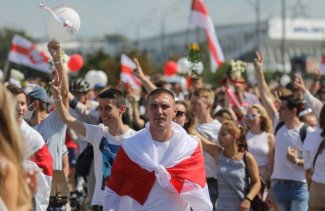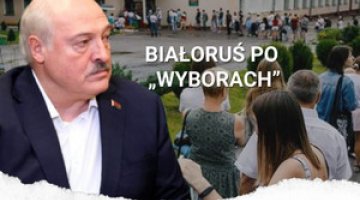The beginning of the end for the regime? Unprecedented escalation of protests in Belarus

Over the last few days, the scale of the protests which now involve almost every city in Belarus has expanded further. The demonstrations are still peaceful, and their numbers vary from tens to hundreds of thousands of people, depending on the locality. In the regions, Grodno has shown a particular potential for protest, where up to 35,000 people gathered. The protests culminated during a peaceful demonstration in Minsk on 16 August; between 100,000 and 150,000 people took part in it, an unprecedented number of demonstrators in the history of independent Belarus. Apart from individual arrests, the police have not intervened.
On 14 August, the wave of protests in Belarusian industrial plants expanded. The workers who ahd been protesting in the previous days were joined en masse by employees of Naftan (petrochemical production), Belkaliya in Salihorsk (potash fertilisers), MZKT (military vehicles) and MTZ in Minsk (tractors), among others. Both the workers and the demonstrators in the streets demanded that the true results of the elections be announced, as well as the release of all detainees and the prosecution of the perpetrators of torture against detainees. Due to the government’s failure to meet the demands, the workers at the above-mentioned factories began a strike action on the morning of 17 August. On 15 August, a significant number of state television employees joined the protests, demanding that the news be presented fairly (previously only individual journalists had quit their jobs). As a result, on 17 August the state-owned channels went on strike, suspending their live broadcasts. Sviatlana Tsikhanouskaya, who has been forced to emigrate to Lithuania, announced that she was ready to act as leader during the transformation of power, but she did not propose a specific political programme.
Although the narrative has become less dramatic and the violent pacification of the demonstrators has ceased, the government has still not released all those detained during the post-election protests (about 4000 people are still under arrest). There were also no specific announcements concerning the punishment of the officers responsible for the brutal treatment of the demonstrators and the bystanders in the vicinity of the protest. The head of the Interior Ministry, Gen. Yuriy Karayeu, despite coming under public pressure, did not consider his resignation justified, and did not rule out the possibility that the police would seek payback for the wave of social ostracism directed against them. Government officials who tried to calm the mood by making public appearances, such as Prime Minister Raman Halouchanka at the MTZ factory and Natalia Kachanava at the TV headquarters, were unable to win the outraged workers over, and their arrogant behaviour in fact brought about an escalation of the protest.
The first manifestations of disloyalty within the mid-level nomenclature have also begin. The director of the Yanka Kupala Theatre in Minsk, Paviel Latushka (a former culture minister), and the heads of Belarus’s embassies in Slovakia and Switzerland have expressed their solidarity with the protesters, and the director of the MZKT factory, Alyaksiej Rymasheuski, admitted at a meeting with his workers that he did not believe that Lukashenka had really won the elections.
Lukashenka has referred repeatedly to the wave of protests in recent days, maintaining his previous assertions that the riots are being provoked from abroad. He once again warned against participating in illegal demonstrations, and threatened the protesting workers with being fired. He also rejected proposals from EU countries to mediate in a dialogue between the authorities and the citizens; instead he spoke of a growing military threat from NATO, which he alleged were building up forces in Lithuania and Poland. In connection with this, Lukashenka held two telephone calls with Vladimir Putin, from whom he obtained assurances that he would provide assistance “if needed” under the mechanisms provided for in the Union State Agreement and the Collective Security Treaty Organisation (CSTO).
On 16 August, in response to a demonstration planned by opponents of the regime, the authorities organised a demonstration of support for Lukashenka in the centre of Minsk. About 10,000 people from different regions of Belarus participated; apart from a group of the president’s supporters, these were mostly state-sector employees who had been forced to take part under the threat of losing their jobs. In a very emotional speech (which state television did not broadcast), Lukashenka called for people to calm their emotions and return to work, which in his opinion would protect Belarus from the chaos and poverty of the early 1990s. In the morning of 17 August the president, as previously announced, met the workers at the striking MZKT plant, to which numerous groups of workers from other factories in the capital started heading. Lukashenka’s attempts to pacify the public mood ended in failure.
Commentary
- The rapid rise in the number of protesters observed since 14 August results from the peaceful form of the demonstrations, as well as the lack of reaction from and near-complete absence of, the security forces. At the same time, the disturbing reports of successive detainees being released from detention, some of whom have been sent to hospitals for treatment, are being widely seen on the Internet, which is having a noticeable effect on the public mood. Two funeral ceremonies for the victims of brutal pacification of demonstrations in the first days after the elections have mobilised the public in Minsk and Homiel over the weekend. Hence, despite the peaceful form of all protests, the demonstrators are radicalising their demands, demanding not only that Lukashenka resign as president office, but also that he should be brought to trial.
- Despite the unprecedented scale of the protests, they still do not have any clear-cut or politically experienced leaders who could formulate a clear plan of action. During the massive demonstration in Minsk on 16 August, Maria Kalesnikava, the only leader of Tsikhanouskaya campaign who has remained in Belarus, announced the victory of her candidate without indicating any further political programme. It is also worth noting that the leaders of the so-called ‘old’ opposition, who have been criticising Lukashenka for years, appear only sporadically at the protests, and have not tried to take the lead.
- The ineffective attempts by Lukashenka’s closest associates to calm the mood of the protesting employees at state-owned enterprises indicate that the authorities lack any constructive idea of how to deal with the crisis. They have only made unconvincing appeals to return to work in the name of maintaining stability and living standards. It is fair to say that the workers, one of the pillars of the regime to date, have lost confidence in the rulers. The collapse of Lukashenka’s authority is confirmed by the strike actions which started on the morning of 17 August, which have begun despite the government’s warnings about the consequences. It is worth noting that many representatives of the nomenklatura, who were educated and trained under authoritarian rule, have demonstrated a complete inability to hold real dialogue with the citizens.
- Recent days have seen representatives of the mid-level nomenklatura renouncing their servitude; however, these demonstrations are of an individual nature, and are not always unambiguous (for example, some have only referred to their support for the right to demonstrate). It is thus difficult to say that the ruling camp is actually collapsing. At the same time, these cases set a precedent which, if the opposition continues to rise and the president fails to respond, may induce other officials to criticise the government in public, or perhaps even go over to the demonstrators.
- An important factor that undermines the regime’s effectiveness is that its propaganda is no longer able to influence the public. Due to the protest on the state television channels, the government’s message no longer reaches all audiences, as was seen in the example of the pro-presidential demonstration in Minsk (which was barely a tenth of the size of the opposition’s); this was broadcast only on the internet, which is the domain of independent circles. As a result, the regime’s opponents now have a much stronger media position, reaching citizens through popular independent news websites and Telegram channels.
- Lukashenka’s anachronistic and aggressive rhetoric has revealed his helplessness in the face of developments and his desperation to maintain power at all costs. This is also shown by his suggestions regarding the use of undefined Russian assistance in connection with a supposed threat to the security of both Belarus and Russia (as can be inferred from the reference to the Union State and the CSTO, this may mean military support). Regardless of the possible involvement of Russia, it seems that there is a growing risk that the authorities will return to the use of force (mainly based on Belarusian security structures), especially as the power of propaganda is weakening and peaceful attempts to silence the demonstrations have failed. Given the mass scale of the protest movement, any new wave of violent crackdowns against the demonstrators would have to be even more ruthless and bloody than those immediately after the elections. Lukashenka seems capable of this, but it is not known to what extent he will be able to count on the security structures.





